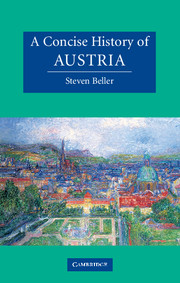Book contents
- Frontmatter
- Contents
- List of illustrations
- List of maps
- Acknowledgements
- Map 1 The Austrian Republic, 2006
- Introduction
- 1 The Eastern March, to 1439
- 2 AEIOU, 1439–1740
- 3 Countering reform, 1740–1866
- 4 Empire on notice, 1866–1918
- 5 The land without qualities, 1918–1945
- 6 Austria Inc., from 1945
- Conclusion
- Guide to further reading
- Index
- CAMBRIDGE CONCISE HISTORIES
- Frontmatter
- Contents
- List of illustrations
- List of maps
- Acknowledgements
- Map 1 The Austrian Republic, 2006
- Introduction
- 1 The Eastern March, to 1439
- 2 AEIOU, 1439–1740
- 3 Countering reform, 1740–1866
- 4 Empire on notice, 1866–1918
- 5 The land without qualities, 1918–1945
- 6 Austria Inc., from 1945
- Conclusion
- Guide to further reading
- Index
- CAMBRIDGE CONCISE HISTORIES
Summary
At the end of January 1996 excavation at a hydroelectric power project at Lambach on the Traun unearthed a mass grave. It was immediately suspected that the human remains were from concentration camp inmates, and Simon Wiesenthal was interviewed on the discovery. He commented that, if one searched, one could find such mass graves ‘everywhere’ in Upper Austria. ‘If you dig in Austria, you can find Roman ruins. You can just as easily find people who were shot to death. After all, Mauthausen had over forty subsidiary camps.’
It turned out that the remains were not those of victims of the Nazis, but of watermen from the nineteenth century. Yet Wiesenthal's comment reminds us of how just scratching the Austrian surface can reveal layer upon layer of a past that has often proved difficult for present-day Austrians to come to terms with. This is true anywhere, but it is particularly poignant for Austria, both because its past is so much greater than the current small republic, and also because the more recent past contains a period, from 1938 to 1945, of national disgrace.
History weighs heavily on Austria. Austrian history is the story of the search for authority; in this search the Habsburg dynasty must play a central role. The Habsburgs took a reasonably successful feudal agglomeration and turned it into the base for imperial power and splendour.
- Type
- Chapter
- Information
- A Concise History of Austria , pp. 311 - 317Publisher: Cambridge University PressPrint publication year: 2007



